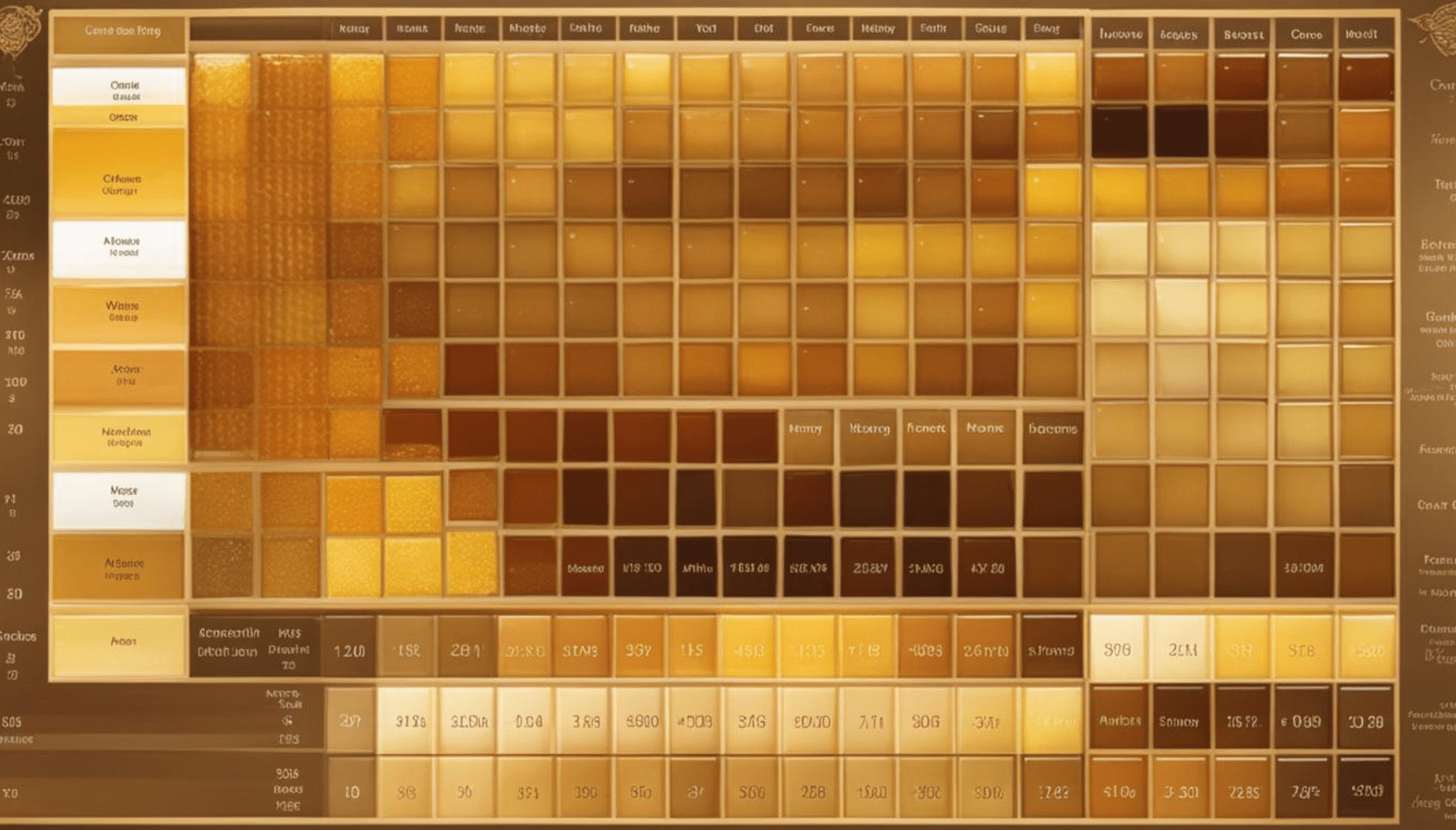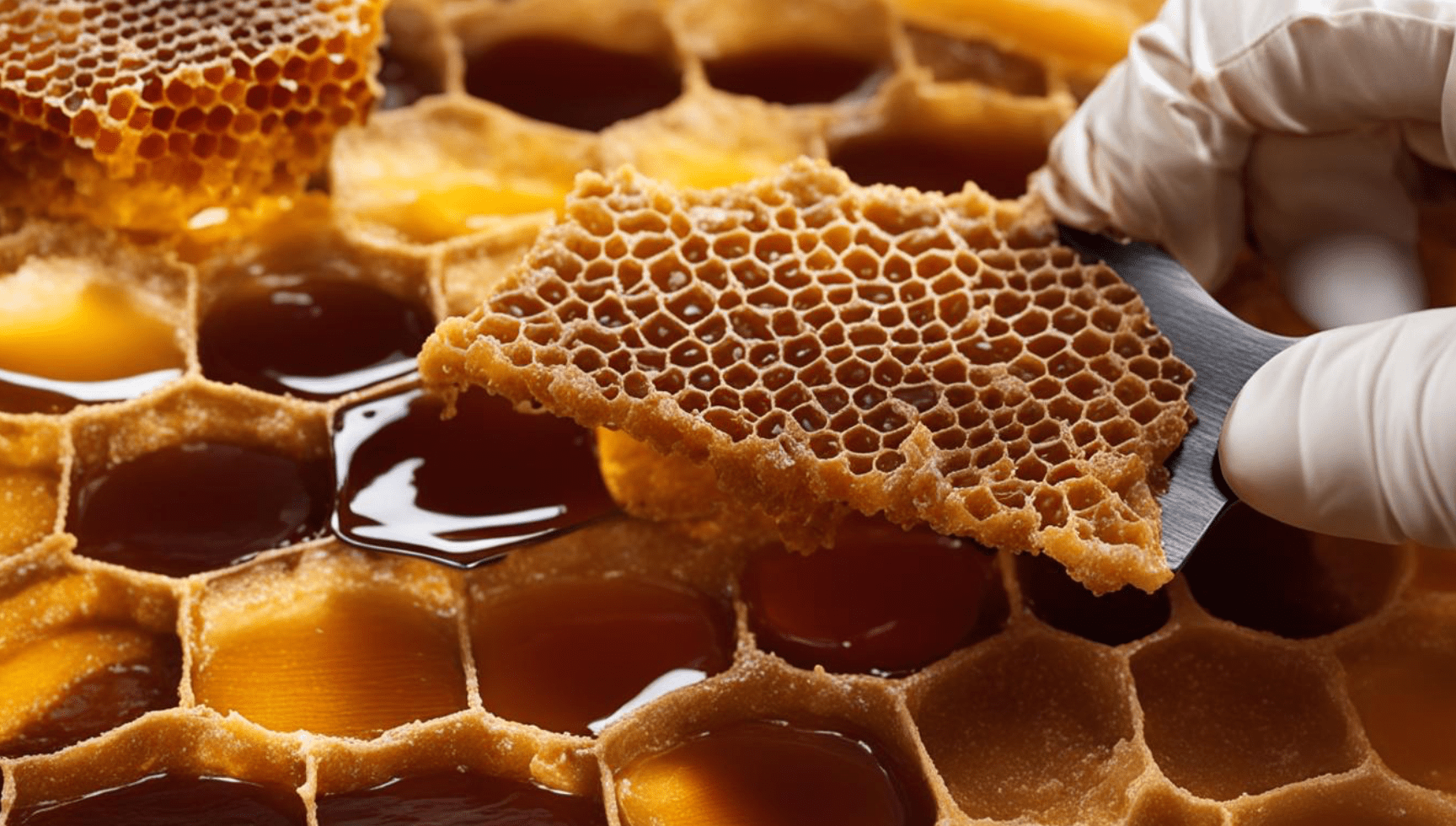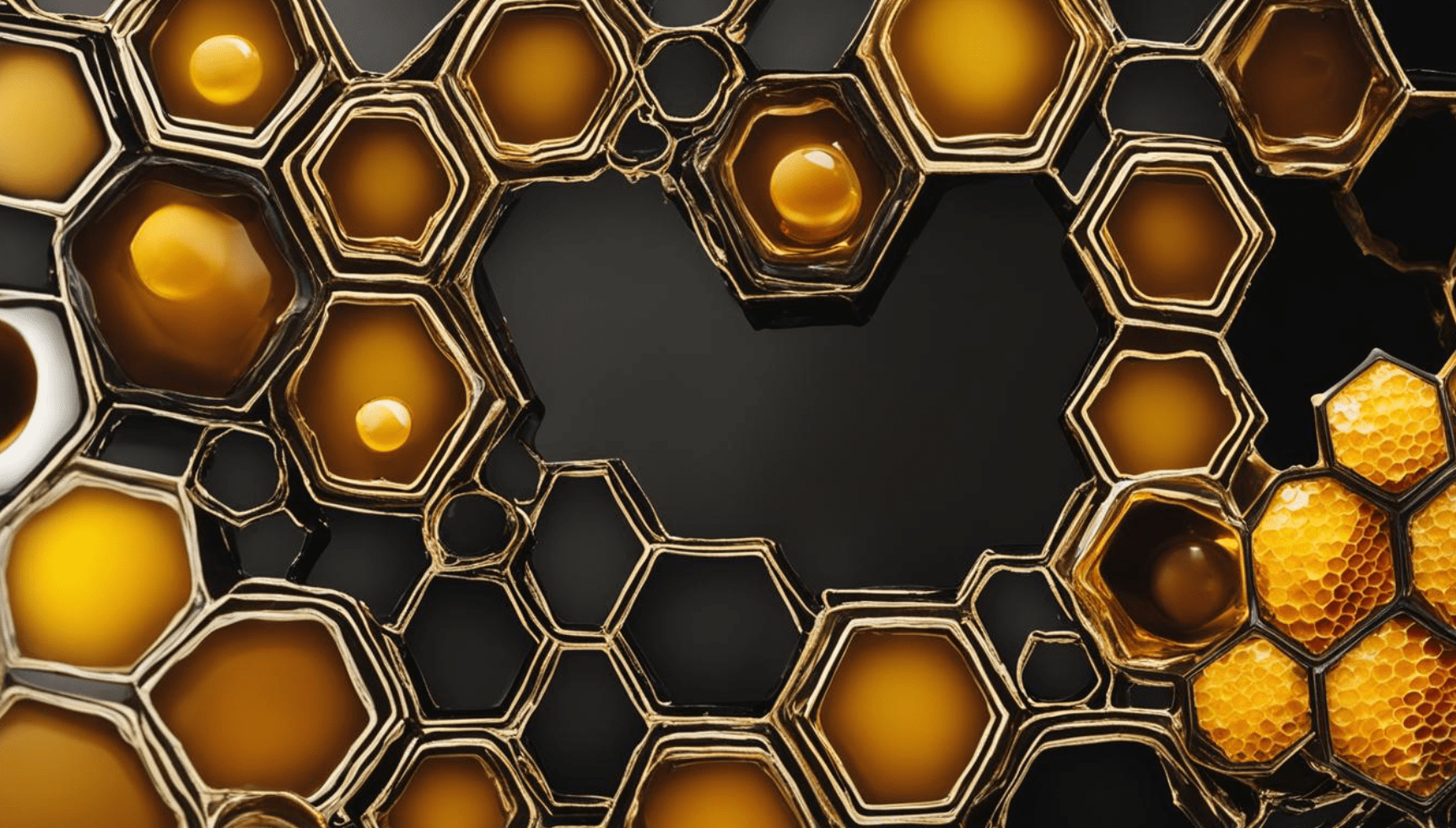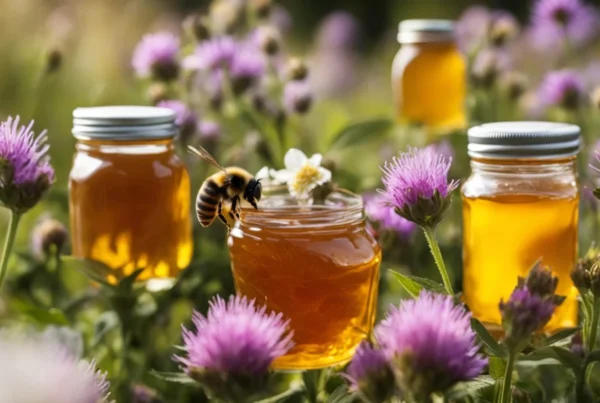If you’re a fan of honey, you might have wondered why one jar tastes different from another. The answer lies in honey grading, a process that assesses the quality and characteristics of honey to determine its grade. In this comprehensive guide, you’ll explore the various aspects of honey grading, including the grading system, standards, charts, and scales, as well as the criteria and process involved in grading honey.

Honey grading is an essential practice that ensures that consumers get high-quality honey while protecting the integrity of the honey industry. From the color and aroma to the texture and moisture content, honey grading takes into account several factors to determine the final grade.
Key Takeaways:
- Honey grading is a process that assesses the quality of honey to determine its grade
- The grading system, standards, charts, and scales all play a role in honey grading
- The criteria used to evaluate honey include color, flavor, aroma, texture, and moisture content
- The grading process involves sampling, analysis, labeling, and categorization
- Honey grading is crucial for both consumers and producers as it ensures consistent quality and value in the honey industry
Understanding Honey Grading
Honey grading is the process of evaluating and categorizing honey based on various criteria to determine its quality and value. The honey grading system and standards vary among countries and regions, but they generally follow similar principles and guidelines. The grading process is crucial for ensuring consistent quality and safety in the honey industry.
The honey grading system typically involves assigning a grade or category to honey based on its physical and sensory properties, such as color, flavor, aroma, texture, and moisture content. The higher the grade, the higher the quality and value of the honey.
The honey grading standards set the criteria for each grade and specify the acceptable range for each property. For example, the USDA honey grading standards in the United States specify that Grade A honey must have a maximum moisture content of 18.6%, while Grade B can have up to 20% moisture.
The honey grading criteria are the specific factors used to evaluate honey and determine its grade. These criteria may vary depending on the grading system and standards, but they typically include the following:
- Color: Honey color can range from nearly colorless to dark amber, depending on the type of flower the bees visited. Lighter-colored honey is generally milder in flavor, while darker honey tends to be stronger and more robust.
- Flavor: Honey flavor can also vary depending on the type of flower, with some honey having fruity, floral, or nutty notes. The flavor intensity can range from mild to bold, with some honey having a delicate sweetness, while others can be quite pungent.
- Aroma: The aroma of honey can also vary depending on the type of flower and can range from mild to strong and distinct.
- Texture: Honey texture can range from smooth and fluid to thick and crystallized. The texture can also be affected by temperature and storage conditions.
- Moisture content: Honey should have a relatively low moisture content, typically below 20%, to prevent spoilage and fermentation.
The honey grading process involves several steps, including sampling and analysis, labeling and categorization, and certification. The grading process should be conducted by trained and certified experts to ensure accuracy and consistency.
Understanding the honey grading system, standards, and criteria is essential for producers and consumers alike to make informed decisions about the quality and value of honey.
The Importance of Honey Quality
When it comes to honey, quality is everything. Honey quality refers to its overall characteristics, such as flavor, aroma, color, and moisture content. These factors are crucial in determining the honey’s taste, texture, and market value. Honey grading systems and standards ensure that honey production meets the desired quality requirements.
Honey quality grading involves a series of evaluations and tests to establish the honey’s unique characteristics. The grading process helps to maintain consistency in honey quality, enabling consumers to make informed decisions when purchasing honey products. Producers also benefit from honey grading by ensuring that their honey meets the necessary quality standards, thus increasing its value and marketability.
The honey grading system is based on specific standards that depend on the type, origin, and processing of the honey. These standards provide guidelines for assessing the quality of honey by examining factors such as moisture content, flavor, color, and aroma. The honey grading system aims to categorize honey products into different grades, depending on their quality.
The honey grading system varies across different countries and regions, but the overall goal remains the same: to ensure that honey is of good quality. The United States Department of Agriculture (USDA) has set specific honey grading standards that producers must comply with to ensure that their honey meets the necessary quality criteria.
In conclusion, honey quality grading and the grading system are essential for ensuring that honey production meets the necessary quality standards. This ensures that consumers can purchase high-quality honey, and producers can maintain the value and marketability of their honey products. Understanding honey quality grading and the grading system is crucial for anyone involved in the honey business.
Honey Grading Systems and Standards
Several honey grading systems and standards exist worldwide, ensuring the highest quality honey production. The grading system typically evaluates honey characteristics, such as flavor, aroma, color, and moisture content, to determine the grade of honey.
In the United States, the honey grading system consists of several grades, including Grade A, Grade B, and Substandard. There are different standards for each grade, such as moisture content and absence of defects.
| Grade | Moisture Content | Absence of Defects |
|---|---|---|
| Grade A | ≤18.6% | No defects |
| Grade B | ≤20.0% | Slight defects |
| Substandard | >20.0% | Defects |
The European Union has its own honey grading standards, including a numerical system that ranges from 1 to 3, with 1 being the highest quality. The criteria for each grade include factors such as color, water content, and absence of defects.
Other countries have developed their own grading systems and standards, such as Canada’s Moisture content and Diastase activity standards, and Japan’s pollen count and glucose content standards.
Despite these differences, all honey grading systems and standards have the same goal: to ensure the highest quality honey for consumers and maintain standards in the market.
Understanding Honey Grading Criteria
Honey grading criteria are essential for evaluating the quality and grade of honey accurately. Various factors affect the grading process, such as color, aroma, flavor, texture, and moisture content.
Color: The color of honey is determined by the floral source and the processing technique used. Honey color can range from pale yellow to dark amber, and it is a vital criterion for grading. Light-colored honey is typically milder in flavor and more expensive, while dark honey is stronger in flavor and less expensive.
Aroma: The aroma of honey is a crucial factor in determining its grade. The scent of honey is influenced by the floral source, and high-quality honey has a pleasant, sweet aroma.
Flavor: The flavor of honey varies according to its floral source, processing, and storage method. Honey can be mild or strong in flavor, and the taste can range from sweet to bitter. High-quality honey has a rich, unique flavor that reflects the characteristics of the floral source.
Texture: The texture of honey is influenced by its moisture content, processing, and storage method. Honey can be smooth, creamy, or crystallized, and it should not have any lumps or crystals. High-quality honey has a smooth, even texture that is appealing to the palate.
Moisture Content: The moisture content of honey is a crucial criterion in determining its grade. Honey should contain no more than 18.6% water, and high-quality honey typically has a lower moisture content.
Why are Honey Grading Criteria Important?
Honey grading criteria are essential for maintaining consistency in the quality of honey produced. By adhering to specific criteria, producers can ensure that their honey meets industry standards and appeals to consumers. For consumers, honey grading criteria provide an indication of the quality and characteristics of the honey, helping them make informed purchasing decisions.
The Honey Grading Process and Criteria
The honey grading process involves careful sampling and analysis of the honey, with each criterion evaluated against a specific range or score. The results are then used to assign a grade to the honey, ranging from A to C based on its quality and characteristics.
The following table showcases the honey grading criteria used in the United States:
| Grade | Color (mm Pfund) | Aroma (mm Pfund) | Flavor (mm Pfund) | Moisture Content (%) | Defects (ppm) |
|---|---|---|---|---|---|
| A | Min 114 mm | Min 57 mm | Min 64 mm | Max 18.6% | 5 ppm |
| B | Between 85-114 mm | Between 43-57 mm | Between 47-64 mm | Max 20% | 10 ppm |
| C | Below 85 mm | Below 43 mm | Below 47 mm | Above 20% | Above 10 ppm |
The table above showcases the criteria used to grade honey based on its color, aroma, flavor, moisture content, and defects. Honey that meets the criteria for Grade A is of the highest quality, while honey that meets the criteria for Grades B or C is of lower quality.
By understanding the various criteria used in honey grading, you can appreciate the intricacies of this process and choose high-quality honey that meets your expectations.
The Grading Process Demystified
Grading honey is a meticulous and scientific process that requires precision and accuracy. Let us explore the specific steps involved in grading honey.
Step 1: Sampling
The first step in the grading process is to collect a representative sample of the honey to be graded. This sample is usually taken from multiple containers to ensure that the honey’s quality is consistent throughout. The sample is then stored in a clean container for further analysis.
Step 2: Analysis
The next step involves analyzing the honey sample for various attributes that will determine its grade. These attributes include color, flavor, aroma, texture, and moisture content. The analysis is usually conducted using specialized equipment and techniques to ensure accuracy.
Table: Example of honey grading criteria
| Grade | Color | Flavor | Aroma | Texture | Moisture Content |
|---|---|---|---|---|---|
| Grade A | Light Amber | Delicate | Flowery | Smooth and Creamy | 18.6% max |
| Grade B | Amber | Mild | Flowery to Spicy | Slightly Crystallized | 20% max |
| Grade C | Dark Amber | Strong | Molasses-like | Coarse | 23% max |
Note: This table is an example and does not represent official honey grading standards.
Step 3: Labeling and Categorization
After the analysis is complete, the honey is labeled and categorized according to its grade, flavor, and other attributes. The labeling must conform to specific regulations and standards, including the type of honey, the net weight, and the producer’s name and address.
Step 4: Certification
Once the honey is labeled and categorized, it undergoes a final round of inspection for quality and authenticity. The honey is certified to ensure that it meets the standards set by the grading system, and that it is genuinely pure and natural.

By following this grading process, honey producers can ensure consistent quality and value for their product, while consumers can enjoy the many benefits of pure, natural honey.
Honey Grading Charts and Scales
Honey grading charts and scales are indispensable tools in the honey grading process. These visual aids help provide a standardized assessment of different types of honey based on various characteristics such as color, aroma, and moisture content.
One of the most commonly used honey grading charts is the Pfund color grading scale, which was developed in Germany in the early twentieth century. This scale ranges from 0 to 140, with a lower number indicating lighter-colored honey and a higher number indicating darker honey. It is essential to note that this scale is subjective and can vary depending on the region.
Another grading scale is the USDA’s honey color and flavor grading system, which is used in the United States. This scale ranges from Grade A light amber to Grade B dark amber, and the National Honey Board provides a detailed chart showing the different grades and their corresponding characteristics.
| Grade | Color | Flavor |
|---|---|---|
| Grade A | Light Amber | Delicate, mild |
| Grade A | Amber | Richer, fuller |
| Grade A | Dark Amber | Robust, full-bodied |
| Grade B | Dark | Strong, bold |
There are also viscosity scales that help categorize honey based on its texture and thickness. The USDA uses a viscosity scale ranging from A to M, with A being the most liquid and M being the most viscous.
Overall, honey grading charts and scales help standardize the grading process and ensure that honey is evaluated consistently. They also provide valuable information to consumers who can use these scales to select honey that matches their preferences.
The Impact of Grading on Honey Quality
Honey grading is a crucial process that impacts the overall quality of honey. By adhering to honey grading standards, consumers can trust that they are purchasing a high-quality product, while producers can ensure consistency and marketability.
The honey grading system is designed to evaluate various factors that contribute to the quality of honey, including color, flavor, aroma, texture, and moisture content. By assessing these criteria, honey can be categorized and graded according to its quality. A higher grade indicates a superior quality product, while a lower grade suggests a lower quality product.
The honey grading standards established by various organizations, such as the United States Department of Agriculture (USDA) and the European Union Honey Directive, help maintain consistency and fairness in the market. These standards dictate the minimum requirements for each grade of honey, ensuring that consumers can trust the product they are purchasing.
Furthermore, the grading process helps identify any defects or inconsistencies in the honey, allowing producers to improve their practices and maintain a higher standard of quality. This benefits both the producer and the consumer, as a better-quality product can command a higher price in the market.
Overall, honey grading plays a vital role in ensuring the quality and value of honey. By understanding the grading system and standards, consumers can make informed choices, while producers can increase marketability and profitability.
Enhancing Your Honey Grading Skills
Becoming a proficient honey grader requires time, practice, and dedication. Whether you’re a beekeeper or a honey enthusiast, honing your grading skills can help you appreciate honey’s nuances and make informed choices when purchasing or selling it.
1. Understand the grading system and criteria
To begin, familiarize yourself with the different honey grading systems and criteria used in your area. Study honey grading charts and scales to gain an understanding of how various factors such as color, flavor, aroma, texture, and moisture content affect honey quality.
You can also join local beekeeping groups and associations to learn more about honey grading techniques and get hands-on experience grading different types of honey.
2. Invest in quality grading equipment
Having the right tools is essential for accurate honey grading. Invest in high-quality equipment such as refractometers, colorimeters, and moisture meters to measure honey’s characteristics accurately. Regularly calibrate your equipment to ensure accurate and consistent results.
3. Practice, practice, practice
Like any skill, honey grading requires practice. Seek out opportunities to practice grading different types of honey to refine your skills. Consider grading honey samples from local beekeepers or purchasing honey from various sources to gain exposure to a range of flavors and qualities.
4. Attend training programs and workshops
To take your honey grading skills to the next level, consider attending training programs and workshops offered by beekeeping associations and organizations. These programs provide in-depth guidance on honey grading techniques, equipment, and standards, as well as opportunities to network with other beekeepers and honey enthusiasts.
5. Keep an open mind
Finally, keep an open mind when it comes to honey grading. Remember that grading is a subjective process influenced by personal preferences and regional standards. Don’t be afraid to experiment with different grading techniques and criteria to develop your own unique approach to honey grading.
By following these tips and investing time and effort into improving your honey grading skills, you can gain a deeper appreciation for this fascinating industry and become a more discerning honey consumer or producer.
Conclusion
From understanding the grading system and criteria to exploring the various grading systems and standards, this guide has provided a detailed insight into the intricate world of honey grading. It’s essential to appreciate the importance of honey quality grading and its significant impact on the honey industry, from producers to consumers.
Grading ensures consistent quality and maintains standards across the industry, providing a reliable measure of honey’s value and desirability. Honey grading charts and scales, along with the grading process, play a vital role in ensuring quality honey production.
Enhancing Your Honey Grading Skills
If you’re interested in becoming a proficient honey grader, there are plenty of resources and training programs available. It takes time and practice to develop your skills, but knowing the grading system and criteria is a great starting point.
By enhancing your honey grading skills, you’ll gain a better understanding of the craftsmanship and dedication involved in honey production. Ultimately, you’ll be able to select high-quality honey based on its grade, taste, and appearance – making informed choices that enhance your honey experience.
Thank you for exploring this comprehensive guide on honey grading. We hope it’s been informative and helpful in understanding the intricacies of the honey industry.
FAQ
What is honey grading?
Honey grading is the process of assessing the quality and characteristics of honey based on specific criteria to determine its grade or classification.
Why is honey grading important?
Honey grading is crucial for both consumers and producers as it ensures consistent quality, helps determine the market value of honey, and allows consumers to make informed choices.
How is honey graded?
Honey is graded based on various factors such as color, flavor, aroma, texture, and moisture content. Experts use standardized grading systems and criteria to assess these characteristics.
Are there different grading systems for honey?
Yes, different countries and regions have developed their own grading systems and standards for honey. These systems may vary in terms of criteria and grading scales used.
Can I learn how to grade honey?
Yes, you can enhance your honey grading skills through resources, training programs, and hands-on experience. Developing a keen understanding of the grading process can help you become a proficient honey grader.



